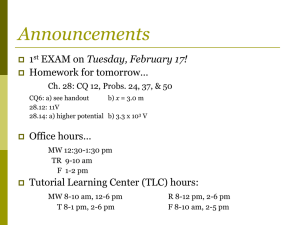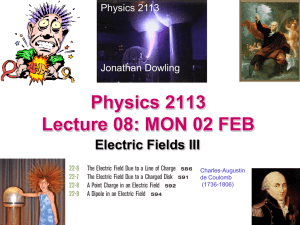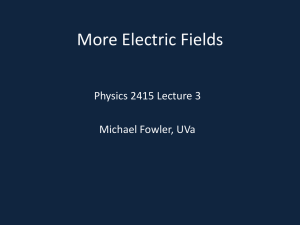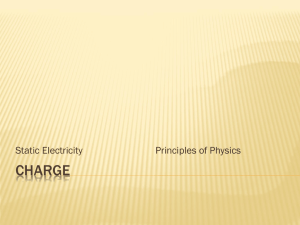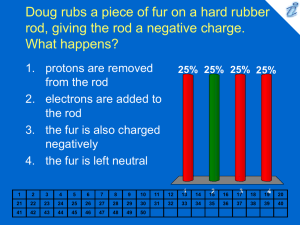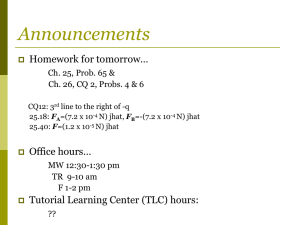Chapter 23 QQ
advertisement
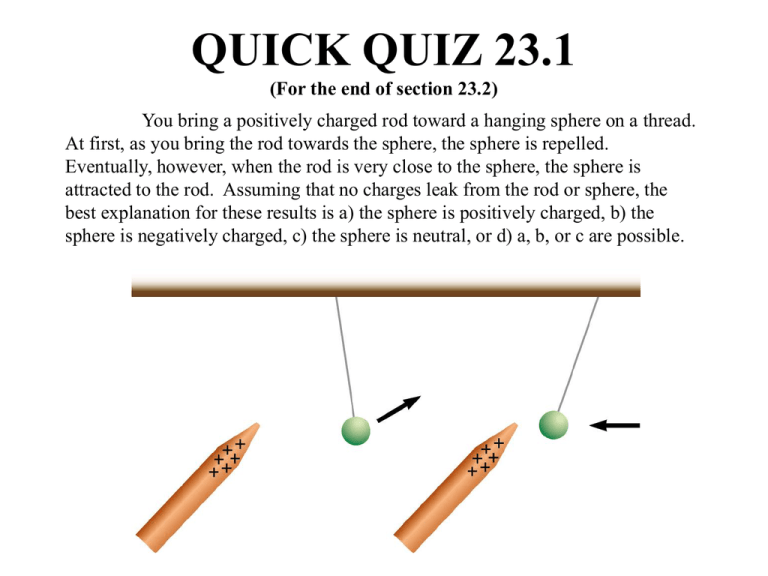
QUICK QUIZ 23.1 (For the end of section 23.2) You bring a positively charged rod toward a hanging sphere on a thread. At first, as you bring the rod towards the sphere, the sphere is repelled. Eventually, however, when the rod is very close to the sphere, the sphere is attracted to the rod. Assuming that no charges leak from the rod or sphere, the best explanation for these results is a) the sphere is positively charged, b) the sphere is negatively charged, c) the sphere is neutral, or d) a, b, or c are possible. QUICK QUIZ 23.1 ANSWER (a) Recall that attraction will occur between objects that are oppositely charged or due to charge realignment. Repulsion will occur between two objects that have the same charge. However, charge realignment will not cause repulsion. If the sphere had a net negative charge or if the sphere were neutral, the rod would never repel the sphere. However, if the sphere had a net positive charge, at large distances the sphere would appear as a positive point charge and repel the rod. At short distances, significant charge realignment could occur and, due to the force dependence on distance, the attraction of the negative charges on the left side of the sphere to the rod could overcome the repulsive forces of the positive charges on the right side of the sphere, even if there were slightly more positive than negative charges. You may verify such an experiment with a pith ball and charged rod. QUICK QUIZ 23.2 (For the end of section 23.3) Two point charges, q1 = +q and q2 = –2q, are fixed at positions on the x-axis, as shown below. If you were to place a third point charge somewhere so that the force on it would be zero, you should place that charge somewhere a) on the x-axis to the right of the two charges, b) on the x-axis in between the two charges, c) on the x-axis to the left of the two charges, or d) off of the x-axis. QUICK QUIZ 23.2 ANSWER (c). Consider a positive point charge placed to the right of the two charges. From Coulomb’s Law, the net force on this third charge is given by: Fnet keq1qo keq2qo . 2 2 r1o r2o Since the magnitude of q2 is greater than q1 and the distance from qo to q2 is less than to q1, the force from q2 on qo will always be greater than from q1 on qo and the net force won’t be zero. At positions in between the two charges, the force on qo will be to the right from both charges. Only at some position to the left of both charges will it be possible to balance the attractive force from q2 with the repulsive force from q1. QUICK QUIZ 23.3 (For the end of section 23.4) Many types of molecules may be modeled as dipoles. For example, two molecules modeled as simple dipoles are aligned on the x-axis, as shown. Each dipole consists of a positive charge q and negative charge –q, separated by a distance d. The distance between the centers of the two dipoles is x. Considering the forces due to all four charges, the net force of one dipole on the other will be a) attractive, b) repulsive, c) zero, or d) it depends on the relative distances d and x. QUICK QUIZ 23.3 ANSWER (a). You can analyze the situation by considering the forces on the left dipole. If the net force on the left dipole is to the right, there is an attractive interaction. If the net force is to the left, there is a repulsive interaction. The charges are numbered 1 through 4 with the various forces on each charge for the left dipole shown on the diagram (the internal forces, that is, the forces between the positive and negative charge within the dipole, are not shown since they are not relevant to the forces between the two dipoles). Considering forces to the right as positive and forces to the left as negative, the net force on the left dipole is: F F41 F32 - F42 - F31 keq 2 k eq 2 k eq 2 2 2 2 2 ( x d ) (x d ) x x 2 (x d )2 x 2 (x d )2 2(x d )2 (x d )2 keq 2 2 2 ( x d ) ( x d ) x 2 The denominator of the fraction will always be positive. The direction of the force is therefore determined completely by the numerator. Looking at the numerator only, we obtain x 2 (x d )2 x 2 (x d )2 2(x d )2 (x d )2 x 2 (2x 2 2d 2 ) 2(x 2 d 2 )2 6x 2d 2 2d 4 2d 2 (3x 2 d 2 ) The minimum possible value for x will be exactly equal to d when the two dipoles are touching. Even in this case, the quantity (3x2 – d2) will be positive. For all values of x and d, therefore, the numerator will be positive and the net force on the left dipole will be to the right. A similar analysis of the net force on the right dipole will yield the same net force to the left, indicating an attractive interaction between the two dipoles. QUICK QUIZ 23.4 (For the end of section 23.5) As illustrated in Figure 23.18 and below, an electric field is produced on the axis of a uniformly charged ring of radius a and total charge Q, at point P a distance x away from the center of the ring. If the charge Q is then spread uniformly into a disk of the same radius at the same location, the electric field at point P a distance x away from the center of this disk will be a) less than for the ring, b) greater than for the ring, c) the same as for the ring, or d) impossible to determine. QUICK QUIZ 23.4 ANSWER (b). As demonstrated in Example 23.8, the electric field on the axis of the ring is due to the charge elements of the ring, all a distance r from point P. In order to visualize the situation, one could approximate the infinite number of infinitesimal charge elements as a finite number of charge elements that add up to the total charge Q. For example, if there were 1000 charge elements, each element would have the same charge of Q/1000. If one were to flatten the ring into a disk and in essence fill up the hole in the ring, except for the outer elements, these charge elements would now be distributed closer to point P than for the ring. In addition, the component of the electric field along the axis would be greater for charge elements closer to the center of the disk. Both of these conditions would produce a larger electric field at point P. QUICK QUIZ 23.5 (For the end of section 23.7) In an experiment similar to the one pictured below, an electron is projected horizontally at a speed vi into a uniform electric field pointing up. The magnitude of the total vertical deflection, ye, of the electron is measured to be 1 mm. The same experiment is repeated with a proton (whose mass is 1840 times that of the electron) that is also projected horizontally at a speed vi into the same uniform electric field. The magnitude of the total vertical deflection, yp, for the proton will be a) 1840 mm, b) 1/1840 mm, c) 18402 mm, d) 1/(1840)2 mm, or e) the same as the electron, 1 mm, since the gravitational forces and therefore mass make negligible contributions to the situation. QUICK QUIZ 23.5 ANSWER (b). From Equation 23.17, y = -eEt2/2m, the vertical deflection is inversely proportional to the mass. The time spent in the electric field is completely determined by the initial horizontal speed, which is the same for each particle. Therefore, the deflection is completely determined by the mass and for the proton will be 1/1840 times as much as for the electron.
